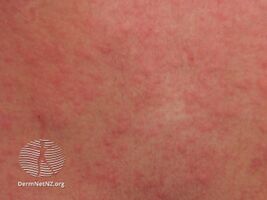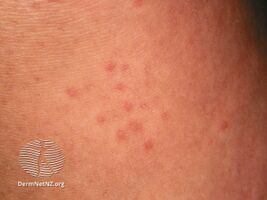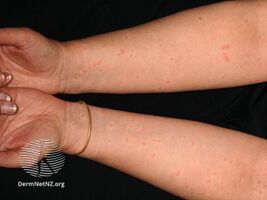Cholinergic urticaria
| Cholinergic urticaria | |
|---|---|
 | |
| CU on the volar aspect of the forearm | |
| Treatment | Antihistamines[1] |
Cholinergic urticaria (CU) presents with tiny very itchy wheals or small bumps on skin on a reddish background.[1]
It is a type of physical urticaria that appears when a person is sweating or their core body temperature increases.[2][3]
Types
Symptoms and signs
Cholinergic urticaria typically presents with a number of small, short-lasting hives but may also involve cutaneous inflammation (wheals) and pain which develops usually in response to exercise, bathing, staying in a heated environment, or emotional stress.[4][5] Although the symptoms subside rapidly, commonly within 1 hour, Cholinergic urticaria may significantly impair quality of life, especially in relation to sporting activities.[6]
-
Cholinergic urticaria
-
Cholinergic urticaria
-
Cholinergic urticaria
Causes
- Sweat hypersensitivity
- Acquired anhidrosis and/or hypohidrosis
- Idiopathic
- Opioid use
- Cholinesterase inhibitors
Prevalence
Though overall research is limited, various studies indicate that CU is relatively common across populations with prevalence rates reportedly ranging from 5% to 20% (depending on locale, race, and age).[7][8][9] The condition is more common in young adults, and prevalence appears to peak in adults aged 26–28 (up to 20%).[7] The vast majority of cases are reported to be mild, and proportionally few individuals seek medical attention regarding the condition.
History
Cholinergic urticaria was first described by Duke[10] in 1924 as "urticaria calorica". The term cholinergic is derived from the finding that hives similar to those of CU can be evoked using cholinergic agonists (e.g. methacholine).
See also
- Miliaria
- Exercise-induced anaphylaxis
- Idiopathic pure sudomotor failure
- Hypohidrosis
- Fabry disease
- Aquagenic urticaria
References
- ↑ 1.0 1.1 James, William D.; Elston, Dirk; Treat, James R.; Rosenbach, Misha A.; Neuhaus, Isaac (2020). "7. Erythema and urticaria". Andrews' Diseases of the Skin: Clinical Dermatology (13th ed.). Elsevier. pp. 151–152. ISBN 978-0-323-54753-6. Archived from the original on 2023-04-29. Retrieved 2023-04-29.
- ↑ Schwartz, Robert. "Cholinergic Urticaria". Medscape. Archived from the original on 25 August 2018. Retrieved 20 March 2018.
- ↑ Nakamizo, S.; Egawa, G.; Miyachi, Y.; Kabashima, K. (2012). "Cholinergic urticaria: Pathogenesis-based categorization and its treatment options". Journal of the European Academy of Dermatology and Venereology. 26 (1): 114–116. doi:10.1111/j.1468-3083.2011.04017.x. PMID 21371134. Archived from the original on 2020-09-30. Retrieved 2020-12-10.
- ↑ Moore-Robinson, M.; Warin, R. P. (1968). "Some clinical aspects of cholinergic urticaria". The British Journal of Dermatology. 80 (12): 794–799. doi:10.1111/j.1365-2133.1968.tb11948.x. PMID 5706797.
- ↑ Hirschmann, J. V.; Lawlor, F.; English, J. S.; Louback, J. B.; Winkelmann, R. K.; Greaves, M. W. (1987). "Cholinergic urticaria. A clinical and histologic study". Archives of Dermatology. 123 (4): 462–467. doi:10.1001/archderm.1987.01660280064024. PMID 3827277.
- ↑ Poon, E.; Seed, P. T.; Greaves, M. W.; Kobza-Black, A. (1999). "The extent and nature of disability in different urticarial conditions". The British Journal of Dermatology. 140 (4): 667–671. doi:10.1046/j.1365-2133.1999.02767.x. PMID 10233318.
- ↑ 7.0 7.1 Zuberbier, T.; Althaus, C.; Chantraine-Hess, S.; Czarnetzki, B. M. (1994). "Prevalence of cholinergic urticaria in young adults". Journal of the American Academy of Dermatology. 31 (6): 978–981. doi:10.1016/S0190-9622(94)70267-5. PMID 7962780.
- ↑ Silpa-Archa, N.; Kulthanan, K.; Pinkaew, S. (2011). "Physical urticaria: Prevalence, type and natural course in a tropical country". Journal of the European Academy of Dermatology and Venereology. 25 (10): 1194–1199. doi:10.1111/j.1468-3083.2010.03951.x. PMID 21175877.
- ↑ Godse, K.; Farooqui, S.; Nadkarni, N.; Patil, S. (2013). "Prevalence of cholinergic urticaria in Indian adults". Indian Dermatology Online Journal. 4 (1): 62–63. doi:10.4103/2229-5178.105493. PMC 3573461. PMID 23437429.
- ↑ DDuke, W. W. (1924). "URTICARIA CAUSED SPECIFICALLY BY THE ACTION OF PHYSICAL AGENTS: (LIGHT, COLD, HEAT, FREEZING, BURNS, MECHANICAL IRRITATION, AND PHYSICAL AND MENTAL EXERTION)". JAMA: The Journal of the American Medical Association. 83: 3–9. doi:10.1001/jama.1924.02660010007002.
External links
| Classification | |
|---|---|
| External resources |


